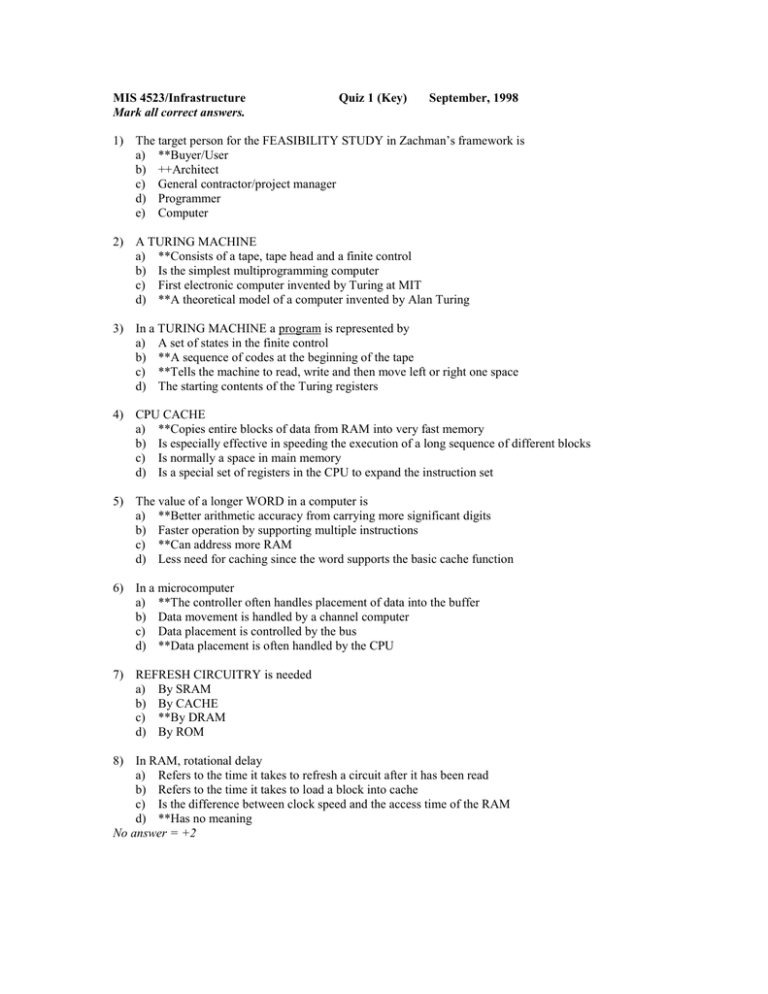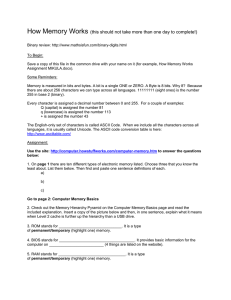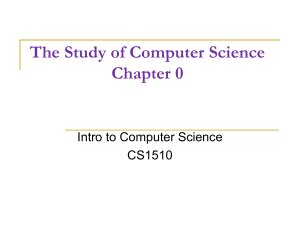Sample Quiz 1 with key (from Fall 1998).
advertisement

MIS 4523/Infrastructure Mark all correct answers. Quiz 1 (Key) September, 1998 1) The target person for the FEASIBILITY STUDY in Zachman’s framework is a) **Buyer/User b) ++Architect c) General contractor/project manager d) Programmer e) Computer 2) A TURING MACHINE a) **Consists of a tape, tape head and a finite control b) Is the simplest multiprogramming computer c) First electronic computer invented by Turing at MIT d) **A theoretical model of a computer invented by Alan Turing 3) In a TURING MACHINE a program is represented by a) A set of states in the finite control b) **A sequence of codes at the beginning of the tape c) **Tells the machine to read, write and then move left or right one space d) The starting contents of the Turing registers 4) CPU CACHE a) **Copies entire blocks of data from RAM into very fast memory b) Is especially effective in speeding the execution of a long sequence of different blocks c) Is normally a space in main memory d) Is a special set of registers in the CPU to expand the instruction set 5) The value of a longer WORD in a computer is a) **Better arithmetic accuracy from carrying more significant digits b) Faster operation by supporting multiple instructions c) **Can address more RAM d) Less need for caching since the word supports the basic cache function 6) In a microcomputer a) **The controller often handles placement of data into the buffer b) Data movement is handled by a channel computer c) Data placement is controlled by the bus d) **Data placement is often handled by the CPU 7) REFRESH CIRCUITRY is needed a) By SRAM b) By CACHE c) **By DRAM d) By ROM 8) In RAM, rotational delay a) Refers to the time it takes to refresh a circuit after it has been read b) Refers to the time it takes to load a block into cache c) Is the difference between clock speed and the access time of the RAM d) **Has no meaning No answer = +2 9) FRAGMENTATION in a DASD refers to a) The number of sectors or blocks per track b) **The scattering of sectors for a dataset due to file updates and deletes over time c) The process of breaking a program into fragments or pages for virtual memory applications d) The ration of words per block in a program file 10) What are the correct values for X, Y, and Z in the HAMMING error correction scheme in the diagram. X 1 0 0 Y 0 Z X = ____1____ Y = ____0____ Z = ___1_____ 11) An INTERRUPT PROCESSOR is a) Responsible for interrupting devices like network interfaces when the CPU needs them b) **Accepts signals from I/O devices when they have completed processing c) A CPU designed for interactive use d) **Responsible for processing error messages from I/O devices and fixing the problem if possible. 12) A MULTIPROGRAMMING operating system a) Is particularly designed for client/server environments b) Requires virtual memory to work c) **Uses short term scheduling to alternate control among several user jobs d) Does not use device drivers 13) In IBM’s MVS operating system a) Has Initiators that are set to run only one class of jobs, but may run several at once b) **Maintains job queues for each class of job prioritized by estimated resource needs c) **Has initiators that run several classes of jobs, but may run only one at a time** d) May assign an initiator to run interactive jobs 14) The PROGRAM COUNTER IN A PROCESS CONTROL BLOCK CONTAINS a) **The address of the next instruction b) The program’s I/O queue position c) The number of the register the program’s using d) The size of the program’s partition 15) TSO operates a) On a separate processor in the IBM operating system b) **As a process in one of the initiators of the MVS batch system c) As a program in the I/O channel computer d) **By polling each of the logged on terminals in turn 16) TSO a) **Communicates with logged on terminals by polling each in turn b) **Gives each terminal a time slice in which it could run batch jobs c) Refers its processing to the class T (TSO) job queue d) Runs on one of the processors in an IBM multiprocessor system 17) MICROPROGRAMMING a) Refers to the instructions supported inside the CPU b) Refers to assembler language modules imbedded in the operating system c) Is efficient machine language code maintained in the kernel d) **Is a set of code instructions burned into ROM and called by the machine language of the system 18) A SCHEDULING ALGORITHM that is used by interactive systems to give each terminal attention in turn a) **Round robin b) Priority c) Multiple Queue d) Guaranteed e) Lottery 19) The memory management technique that involves transferring the memory records of a process into secondary storage when the process is not running is called a) **Swapping b) Partitioning c) Paging d) Blocking 20) The memory management technique that leaves large holes of unusable space in memory is called a) Swapping b) **Partitioning c) Paging d) Blocking 21) Addressing scheme used by the CPU is a) **Physical Address b) Relative Address c) Logical Address 22) The Page Table a) **Contains the current location o a given page b) Contains the current location of a given instruction c) ++Must always be contained in main memory d) **Can be paged in and out of memory like other parts of a program 23) The CONTROLLER in a block addressable device like DASD a) **Contains a buffer and registers b) Manages paging for a virtual memory machine c) **May write data from its buffer directly into memory locations specified by the CPU d) Writes data directly from the disk to main memory in a stream 24) The OS goal of letting multiple users READ from the same disk without knowledge of the other program actions is a) **Device Independence b) Uniform Naming c) Transparent Error Recovery d) Blocked Logical Operation e) **Transparent Device Sharing 25) DEADLOCK refers to a) An interrupt that occurs when a disk cannot locate a given data element b) ++Two programs requesting services at the same time c) **Several programs waiting for resources that other members of the set have reserved d) Any error that requires restarting the operating system 26) Killing one of the deadlocked processes and restarting it later is a strategy for a) An Ostrich strategy b) **Deadlock detection and recovery c) Deadlock prevention d) Deadlock avoidance 27) Spooling the input for all devices is a strategy for a) An Ostrich strategy b) Deadlock detection and recovery c) **Deadlock prevention d) Deadlock avoidance





